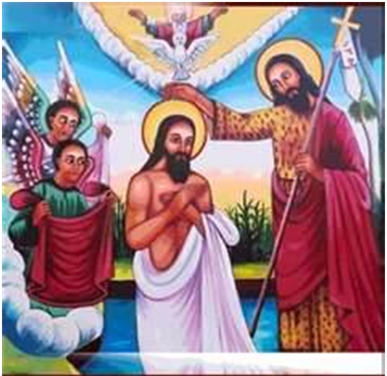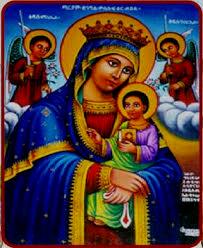October 10, 2016
The Holy Cross is a sign of peace and foundation of Christianity. The main purpose of this short article for 2008/2016 anniversary of the True Cross is to illustrate that true peace cannot be achieved without the Holy Cross which signify Christ’s passion and death.
When we celebrate the finding of the True Cross to get peace which we need desperately, we should keep in mind that Christ’s Cross is the foundation of peace, and we should announce its mystery to the world.
As we all know there are three basic necessities of human beings. These are: Food, Clothe and Shelter. One thing which is more important than these three is Air/Oxygen. Since oxygen is not countable or calculable in terms of money, economists did not consider it among these necessities. But, they do know how much it is necessary.
When it is explained in religious aspects, the very important thing is knowing God and to have faith in Him. “Man shall not live by bread alone, but by every word that proceeded out of the month of God” Matt.4:4 This is the word of our Lord, the basic principle of our Religion, and a word which is a base for our life.
Without any difference peace is very significant to individual life of the human being, family, society, country and to the world. There are some people who try to classify peace as positive and Negative. But in Christian doctrine peace is always positive. With this perspective, there is no negative peace. A peace created by the agreements of people proceeds from peace seeking party and provider. Such kind of peace is based on common interests and is more productive. Also this kind of peace is long lasting.
Above all, a peace which is coming from reconciliation with God by repentance and by avoiding sin against God is not only long lasting but also a kind of peace from God Himself. This is a basic concept when we preach about peace according to the Christian faith and doctrine. When the church uses this perspective on peace and when it is preached this why the effort to bring change on individuals, families, society, country and on the world, will be successful.
The Holy Cross is a Foundation of Peace
The Hebrew word “shalom” is found in many Semitic languages and can be defined as “wholeness” and “healthiness’. The word is used for greetings, to wish the best, and to say good bye. According to Kidanewold Kifle’s definition, the Geez equivalent word “Selam” connotes perfect health, rest, reconciliation, unity, wellness, joy happiness, greeting, benediction and a word of good bye. The Holy Cross and peace relate each other by being a base one for the other. Also because of this meaning of peace, one is a fruit of the other as they interrelate.
Scholars say the Holy Cross is a means for reconciliation of the seven contradictory enemies. These seven conflicting enemies are soul and body, Man and Angels, Human beings and God, and Heaven and Earth. The major problem between these conflicting bodies is sin. Sin affected the magnificent relationship between God and Man and human relationship among themselves. The effect of sin is seen in disturbed relationship among human beings. At last, the Holy Cross restored the wonderful relationship between God and Man and between man and his neighbor. Because of this we say the Holy Cross is the foundation of peace and peace is the fruit of the Holy Cross. If we want to understand the relationship between the Holy Cross and peace, and if we want to understand the peace gained from Christ’s Cross and its value to our individual, family, societal, national and worldly life well, we should not try to see the Cross and peace separately.
It is true that the Cross was an instrument of criminals. But now, the Holy Cross is a mystery in which God saved the world by the death of His Son. Because of Christ’s death for the transgressions of humans, the mystery of the Holy Cross is salvation, reconciliation, providing peace, eradication sin- which was the reason for life without peace, destroying the wall of enmity between God and human beings, and preaching peace as the necessity of human life. The Holy Cross preaches peace when it is seen on the upper roof of the church, when it is in the hands of Christians when they tie it up on their neck, and when it is painted on the body and clothes of Christians. Off course, the peace which is not in our internal life cannot be achieved by this all. The cross will be a source of peace when we believe on the crucifixion of Christ by understanding eh mystery of the Cross, living the Christian life for the sake of God and by avoidance of sin.
The world’s Effort for Peace
Man is a peace seeking being in his nature. But there are reasons to fail what he wants to achieve and what he wants to give for others. These reasons can be religious, political, economic, cultural etc. But the major problem is religious. People do not give much attention for this major problem. In contrast, they try their best to bring peace by their own efforts. Religious institutions work with different international organizations and with governments in addition to their endeavors to teach people to seek peace.
There are a lot of reasons not to have peace. Due to these the world is under the dangers of natural and manmade disasters. States are spending a large amount of money to protect their nation from internal and external enemies. “Peace, Peace…” is being broadcasted in world medias today. The usual sign white dove with olive leaf in its beak is being painted in different magazines, Newspapers, and mass Medias are discussing much about it. The United Nations’ messengers are trying to bring peace and reconciliation in different parts of the world. Awards are given for those who made more efforts to bring peace.
These all efforts were to minimize the tensions happened in the world. But human efforts didn’t help to achieve real and everlasting peace to the world. Because, this kind of peace is given only from God.
Peace is a Gift of God
As witnessed by St. Paul the Apostle God is a God of peace. “Now the God of peace be with you all” (Rom. 15:33) “And the God of peace shall bruise Satan under your feet shortly (Rom.16:20) After His resurrection Jesus Christ himself revealed to disciples and said to them “Peace be unto you” (John.20:23-19) God promised about peace with the following words:-
“I will give peace in the land” Lev.26:6.
“Peace I leave with you, My peace I give unto you” Jn.14:27.
“The lord will bless his people with peace” Ps.29:11.
“He will speak peace unto his people, and to his saint” Ps.85:8.
“Lord thou wilt ordain peace for us; for thou also hast wrought all our works in us” Isa. 26:12.
“And my people shall dwell in a peaceable habitation, and in sure dwellings, and in quite resting places” Isa.32:18.
God promised his people through prophets saying “I will give you peace”. Christ said to His Apostles “Peace I leave with you, my peace I give unto you; not as the world gives, give unto you”. Let not your heart be troubled, neither let it be afraid. Jn.14:27. This indicated that true peace comes only from God.
When and how this peace will be acquired? The answer is when every individual believes on God with love which is revealed by His Son Jesus Christ. As a result of man’s disagreement with God, man hates and hurts himself and others and his environment as well. So let’s reconcile and agree with God. In the book of Job, Eliphaz the Temanite advises us saying “Acquaint now thyself with him and be at peace; there by good shall come unto thee” (Job.22:21)
In relation to this Saint Paul also said; “Now the Lord of peace himself gives you peace always by all means” Thess.3:16.
“And the peace of God, which passes all understanding, shall keep your hearts and minds through Christ Jesus” Philip.4:7.
Christ is the Prince of Peace for He is Our Peace (Ephe.2:14)
“For unto us a child is born, unto us a son is given; and the government shall be upon his shoulder; and his name shall be called, wonderful counselor, the Mighty God the everlasting father, the Prince of Peace”
As foretold in this prophecy, on the day of Christ’s birth Angeles and shepherds rejoiced together saying “Glory to God in the highest, and on earth peace, good will toward….” Luke.2:14.
This is the fruits of Christ’s blood, who died on the Cross to bring peace between God and man and between man and his neighbors.
“And having made peace through the blood of His Cross, by him to reconcile all things unto himself; by him, I say, whether they be things in earth, or things in heaven” Col.1:20, as it is written Christ is our peace. Christ shed His blood on the Cross to give us peace. This shed of blood for love is a source of our peace. The Cross, the precious blood shaded on it, is a base and sign of our peace.
St. Yared said the following about the relationship between the Holy Cross and peace. “The Cross is a light for the whole world, a foundation of the church, giver of peace is savior of the world, and for us who believe the Cross is a remedy”.
God’s peace can control our heart. “And let the peace of God rule in your hearts, to which also you are called in one body; and be thankful” (Col.3:15). If we have peace that controls our heart, the other parts of our body will be controlled by our heart and this means all parts are surrendered to the real peace. Now, we can say man is at real rest. How sad it is to be outside this peace and how can it be explained?
Peace is the Fruit of the Sprit
As we are told in Galatians 5:20 “Strife and emulation are fruits of the flesh.” And peace is the fruit of the Sprit. A person who has peace is spiritual; he tries for others to be peaceful and to live peacefully. (Matt.5:9, Eph.6.15) We should live God’s peace in our life. The word of God says, “If it be possible, as much as lieth in you live peaceably with all men” (Rom.12:18).
“And be at peace among yourselves” (Thess.5:13).
“Depart from evil, and do well; seek peace and pursuit it” (Ps.34:14).
Conclusion
The Sign of Peace
In one side peace is the ultimate desire of a community. Therefore, to have peace we have to do some other things. In another side peace is a precondition to achieve other societal interests. For example where there is no peace, there is no way to development justly and equally. In this case peace and development are inseparable things.
The need for peace is also inseparable from the need for God’s word, Grace and Mercy. Because of our differences of understanding on the source of peace our position on peace will be different. According to Christianity’s teaching peace is the property of God, and a great gift from God to human beings. The main reason for the absence of peace is also disagreement with God, the source of peace.
Some people consider peace as their own production. Off course, man in his nature is peaceful and lover of peace. Therefore he pays his most effort to have peace. But Sin is always in between and misdirecting the world. The world, which is controlled by Sin, unable to see the source of peace, but understands the absence of peace which is the result of Sin.
The church teaches people that they lost peace because of their disagreement with God. And also the church announces that peace is restored by the prince of peace-Christ and by His Cross. Since it is a religious mystery, a common agreement is not expected. Those who will agree are people who know the word of God and who understand His will. These people should teach others about the need for peace, its source and with what people should do to achieve peace.
“But now in Christ Jesus who sometimes were far off are made nigh by the blood of Christ. For he is our peace, who hath made both one, and hath broken dawn the middle wall of partition between us. (Eph.2:13-14).
Based on the above verse, the church and church members should do the following to keep both the church’s and their country’s peace.
1. Teaching peace as the gift of God and how much it is needed.
Education can direct Man’s misconduct. Education makes sinners righteous, non-believers believers, and a way to change people’s mind to peace seeking mentality. In this case evangelization is God’s law to preach peace to people. So, we have to teach people the Gospel of peace.
2. All believers should have an exemplary life holding peace in their life.
The peace which we are preaching must be reflected in our life. This will have more convincing power than words.
3. Peace keeping is a common responsibility of the church and the government.
Therefore we have to work together with the government. Peace is the necessity of human beings and a guarantee of existence. Peace is a common interest of human beings, not one group’s world view. The way to serve all human beings is to give peace to them. Hence, having the example of the God of peace Jesus Christ, the church should work on peace. This is the meaning of the Cross.
May God protect our country’s and people’s peace!
O, king of peace Jesus Christ, gives us your peace. Amen!
Source: Taken from “Bulletin” prepared by Ethiopian Orthodox Tewahedo Church Publication Committee for 2008/2016 anniversary of the True Cross.




